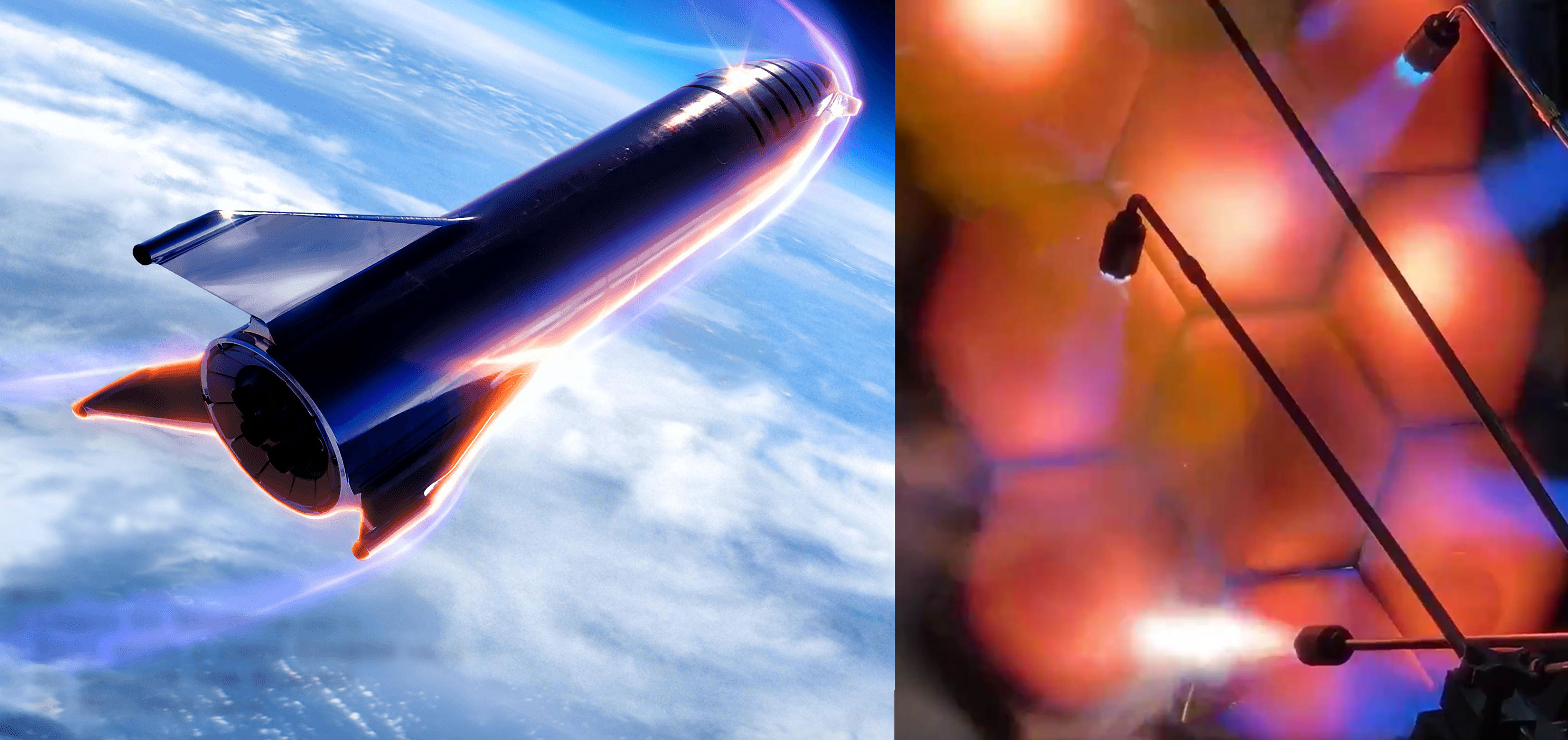

News
SpaceX CEO Elon Musk hints that Starship’s ‘sweating’ metal heat shield is no more
In the latest entry of SpaceX’s ever-changing Starship design process, CEO Elon Musk has indicated that the nominally reusable orbital spacecraft has moved away from a liquid-cooled steel heat shield to something slightly more traditional.
This information came as a SpaceX engineer announced during Cargo Dragon’s CRS-18 webcast that the twice-flown spacecraft would mark the first orbital test of a ceramic heat shield tile meant for use on Starship’s windward side. This major design change comes as a significant surprise and seems likely to either delay Starship’s orbital debut or hinder its ultimate reusability, although Musk just as recently claimed that the spacecraft could reach orbit for the first time less than six months from now.
Testing a possible Starship windward side ceramic tile. Maximizing emissivity is best for conductive/particle heating. Nice thing about steel is that tiles can be very thin, unlike carbon fiber or aluminum airframe.— ln(e) (@elonmusk) July 25, 2019
Thin tiles on windward side of ship & nothing on leeward or anywhere on booster looks like lightest option— ln(e) (@elonmusk) July 25, 2019
Back in late-2018 and early-2019, Musk took to Twitter to announce that SpaceX was pursuing an exotic metallic heat shield that would be cooled in large part by flowing liquid methane through tiny holes on its exterior, effectively ‘sweating’ away energy and preventing steel tiles from melting.
Despite incontrovertible evidence that SpaceX performed some amount of significant testing on the hexagonally-tiled steel heat shield concept, Musk’s July 24th tweets indicate that the liquid-cooled heat shield is unlikely to ever be used on Starship. For unknown reasons, SpaceX is instead pursuing some sort of thin ceramic heat shielding to protect the entirety of Starship’s windward side (i.e. the side facing the atmosphere during reentry). A handful of the first flight-qualified ceramic tiles – shaped for Dragon instead of Starship – will be tested on Cargo Dragon during the spacecraft’s orbital mission and eventual reentry.
Of note, this is not the only major design change Starship has undergone in just the last few months. Speaking on May 30th, Elon Musk stated that the design of Starship’s landing legs/fins and actuating wings and flaps has changed significantly since SpaceX revealed the new tripod fins + canard wings configuration in September 2018. According to Musk, that change will (or at least should) not significantly impact Starship’s schedule.
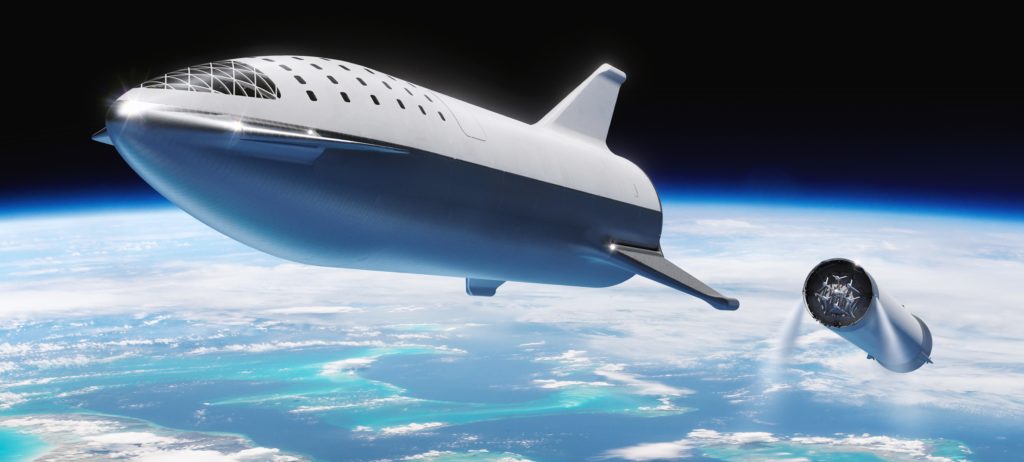
In fact, per his July 2019 claims that the first full-fidelity Starship prototype(s) could begin test flights in September/October and reach orbit as early as December/January, the Starship/Super Heavy schedule has actually radically sped up in the first half of 2019. In December 2018, Musk stated that he believed Starship had a 60% chance of reaching orbit in 2020, let alone late-2019.
For Starship, the massive spacecraft’s heat shield is arguably its single most important component. A failure to ensure that the heat shield is unprecedentedly reusable and reliable – even in the face of ultra-high-velocity interplanetary reentries – will severely limit Starship’s ability to achieve its ultimate goals of enabling affordable access to space and building a sustainable city on Mars. Musk’s comment that ceramic tiles are just “a possible” Starship heat shield element further indicates that SpaceX has yet to firmly settle on a heat shield design, let alone qualify said shield for orbital flight or kick off the mass-production necessary to completely cover multiple Starship halves.

Admittedly, there is still some good news in this unfortunate development. Most notably, the fact that Starship will still be made of steel means that the non-metallic heat shield tiles can be extremely thin and light, as they can be more or less directly attached to Starship’s steel hull. Additionally, steel Super Heavy boosters may be able to get away with zero heat shielding thanks to the relatively high melting point and heat resistance of certain varieties of stainless steel.
So long as both of those characteristics remain true, it’s likely that it will still make sense for Starship/Super Heavy to be built entirely out of steel instead of something like aluminum or carbon composite. With any luck, Elon Musk will provide a detailed update on the status of SpaceX’s next-generation launch vehicle soon after Starhopper survives its first untethered flight test.
Check out Teslarati’s Marketplace! We offer Tesla accessories, including for the Tesla Cybertruck and Tesla Model 3.
Elon Musk
Elon Musk confirms Grok 4 launch on July 9 with livestream event
The rollout will be accompanied by a livestream at 8 p.m. Pacific Time.

Elon Musk has officially confirmed that Grok 4, the latest version of xAI’s large language model, will launch on July 9. The rollout will be accompanied by a livestream at 8 p.m. Pacific Time, hosted on xAI’s official account on X.
xAI goes straight to Grok 4
Back in May, leaks indicated that xAI was getting ready to ship Grok 3.5. Considering Musk’s recent comments, however, it appears that the artificial intelligence startup would be focusing on the large language model’s fourth iteration instead. As noted in a Financial Express report, users on X have sighted references to Grok 4 in the lead up to the update’s launch, such as “grok-4-prod-mimic” and “Grok 4 Code.”
Musk’s Grok 4 announcement comes as AI competition intensifies between major players including OpenAI, Google, and xAI. With Musk’s Colossus supercomputer fully operational in Memphis, xAI appears to be accelerating its AI product roadmap.
Musk pushes Grok toward political neutrality
Grok 4’s launch also follows a recent controversy involving political bias, as noted in a CNN report. Last week, Grok responded to a user on X stating that political violence in the U.S. since 2016 had come more from the political right than the left. The chatbot noted in a later reply that its answer was based on information from sources like Reuters, the Journal of Democracy, and University of Maryland studies.
Musk stated that Grok’s response was a “major fail.” “Major fail, as this is objectively false. Grok is parroting legacy media. Working on it,” he wrote in a post on X. By the end of June, Musk noted that he was “grinding all night with the xAI team” and that they were making “good progress.” He also stated that the model “Will be called Grok 4. Release just after July 4th. Needs one more big run for a specialized coding model.”
News
Tesla opens massive solar Supercharger station in California
The Supercharger opened to customers ahead of Fourth of July weekend, while Tesla continues phase two of construction on the site.
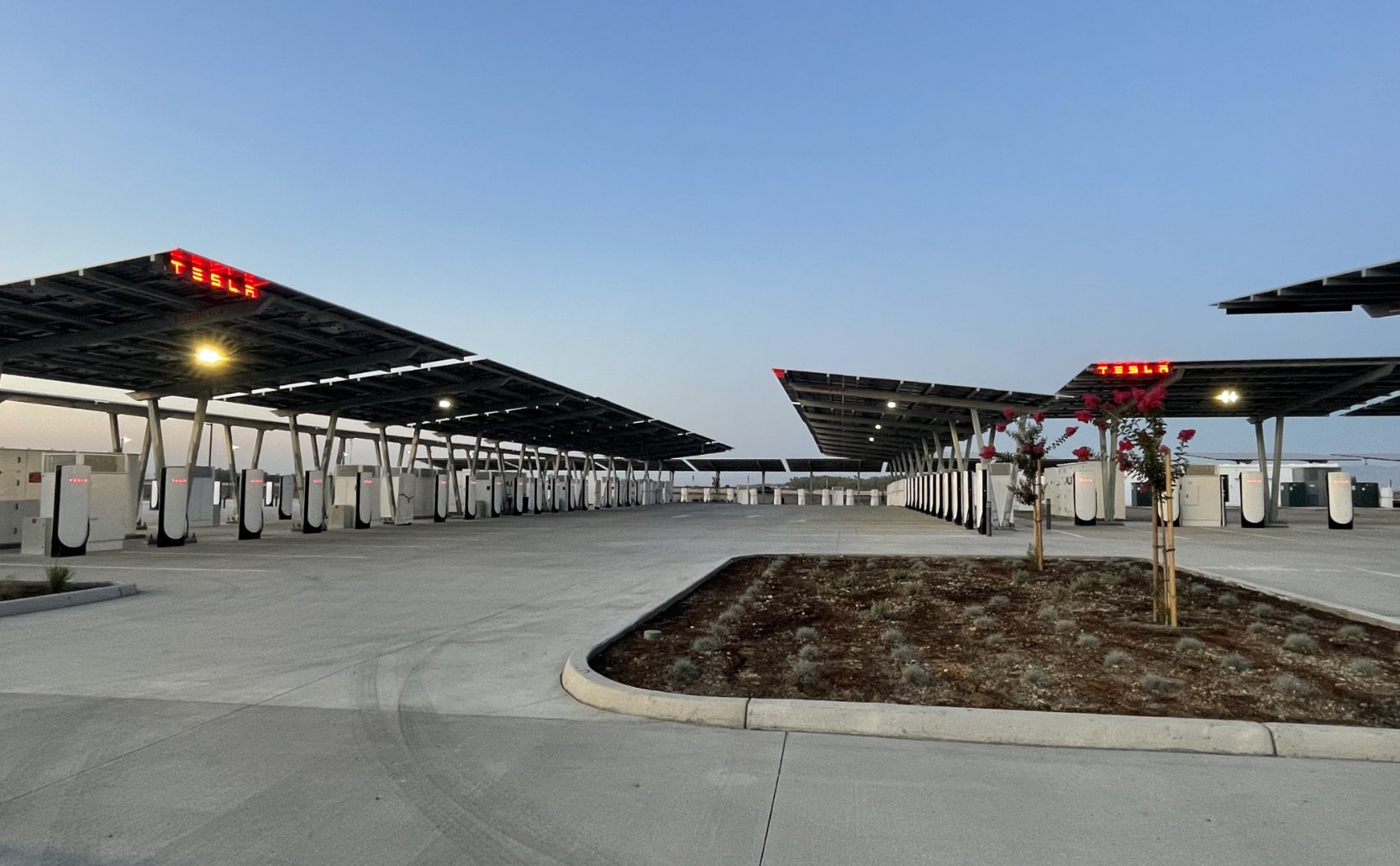
Tesla has officially launched the first several Supercharging posts at a massive station in California, notably including solar canopies and grid-scale batteries to offer completely renewable charging.
Last week, Tesla announced on X that it opened the first 84 Supercharger stalls of a planned 168-stall station in Lost Hills, California. Additionally, the massive Supercharger project features 11MW of solar canopies and 10 Megapack batteries for off-grid charging powered entirely by solar energy.
Tesla completed the first phase of the project just days ahead of the busy Fourth of July holiday weekend, adding that initial construction took just eight months. In addition to the remaining charging stalls, Tesla says it’s building a set of lounge areas, renderings of which can be seen below alongside current photos of the site.
Notably, the site also includes V4 charging posts for the company’s latest available charging speeds, and it’s located near the busy junction between I-5 and Highway 46 in Kern County.
“Thank you [Kern County] and [PG&E] for collaboration and approvals,” Tesla wrote in a follow-up post.
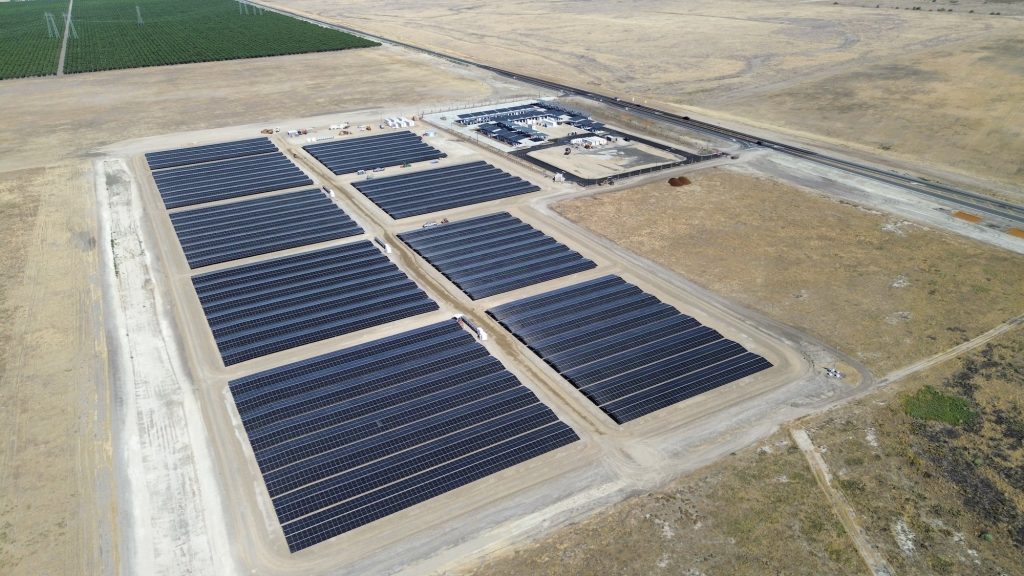
Credit: Tesla Charging | X
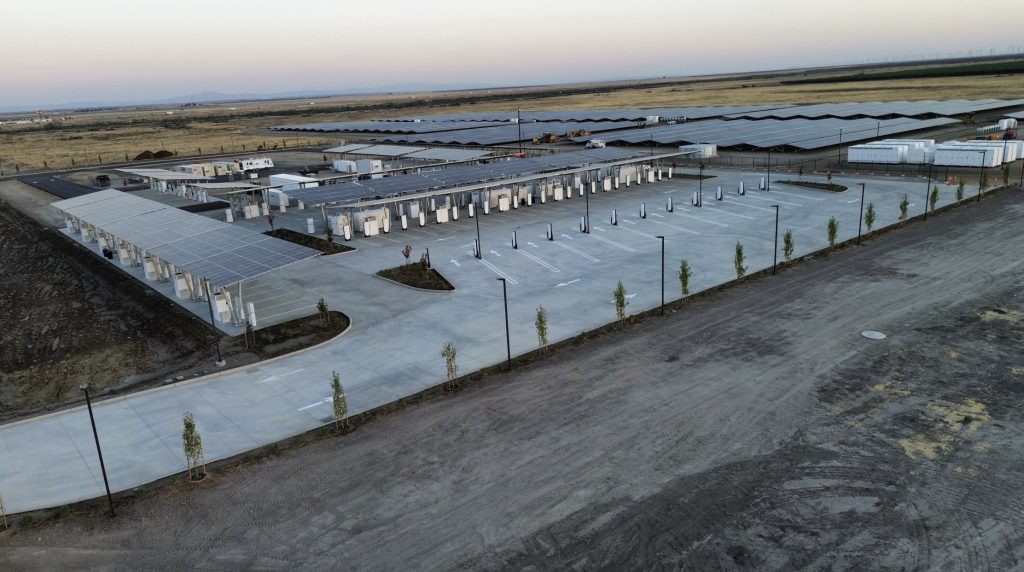
Credit: Tesla Charging | X
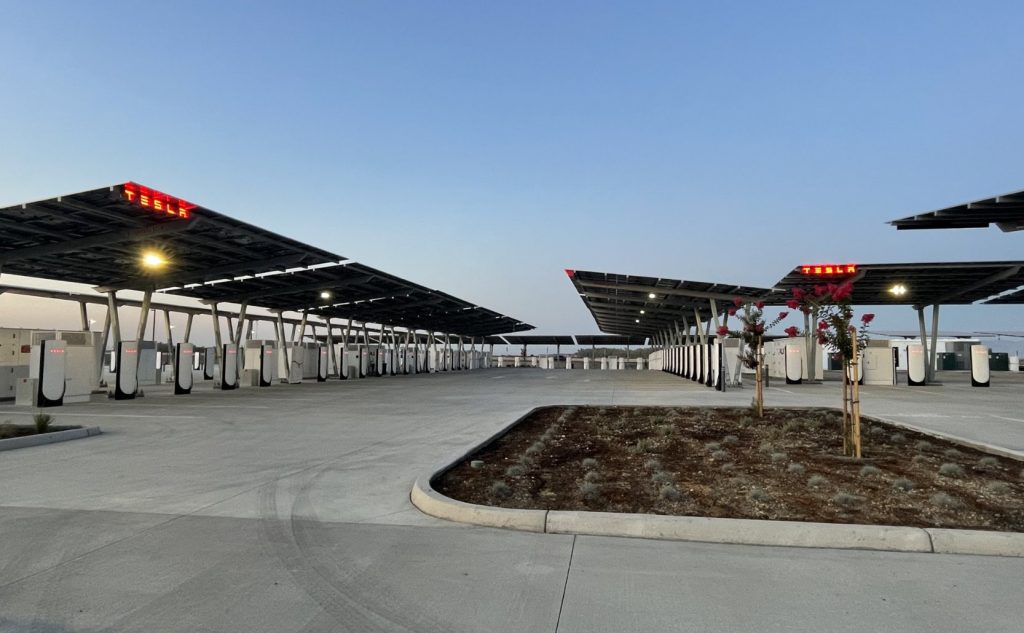
Credit: Tesla Charging | X
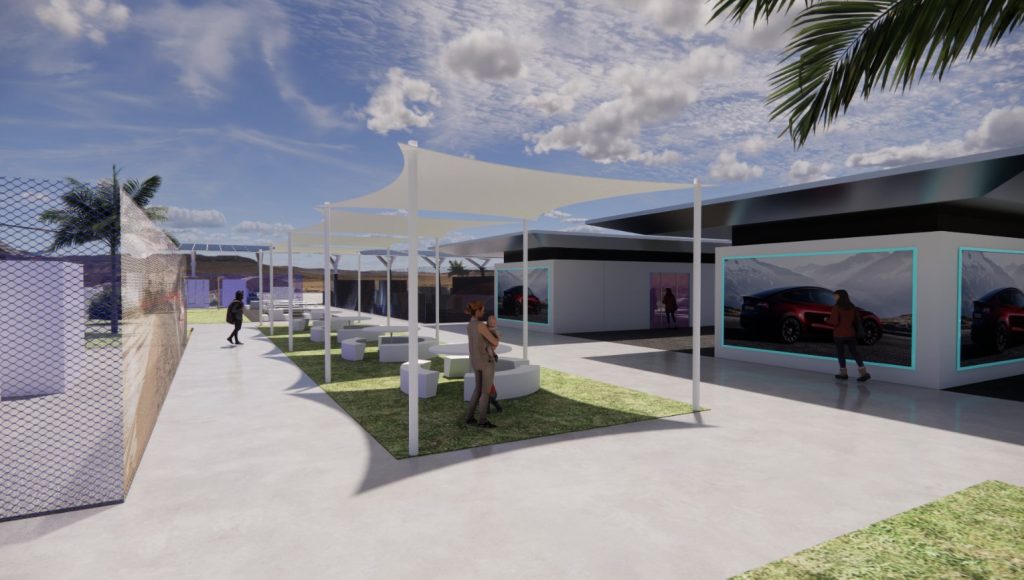
Credit: Tesla Charging | X
Tesla Supercharger Maps for North America, Europe, and Asia pic.twitter.com/0U5r0XRPyo
— TESLARATI (@Teslarati) July 2, 2025
READ MORE ON TESLA SUPERCHARGERS: Tesla launches ultra-fast V4 Superchargers in China for the first time
Testing at the LA Diner, plus Musk update on potential Tesla solar Gigafactory
The huge Tesla Supercharger station completed phase one of construction fairly quickly, especially given how long Tesla has been working on its unique Los Angeles diner, drive-in, and Supercharger location. Still, the company was seen performing some testing at the nearly-completed charging station earlier this month, and will reportedly be holding a job fair.
Elon Musk also responded on Monday morning to a post on X, suggesting that Tesla is “thinking about” building a U.S.-based solar Gigafactory in order to help support increased power needs with AI growth, and to bolster domestic solar production.
Tesla is building a new UFO-inspired Supercharger in the heart of Alien country
News
Tesla driver walks away from major accident with minor injuries
The driver sustained only minor injuries, and the exact cause of the crash remains under investigation.

The driver of a Tesla Model Y survived and walked away from a harrowing accident on Monday in California, only sustaining minor injuries despite the vehicle being impaled by a guardrail.
On Monday morning around 4:34 a.m., the Los Banos division of the California Highway Patrol (CHP) responded to the accident on I-5 near Panoche Road, involving a 23-year-old in a Tesla Model Y. According to a post on social media, the driver veered off the road for unknown reasons in the northbound lane, before crashing directly into the guardrail and impaling the vehicle.
You can read the full message and photos from Los Banos CHP below, as were shared in a Facebook post on Monday afternoon.
This morning a Tesla model y was traveling in the #1 northbound lane of I-5 north of Panoche Rd. For unknown reasons driver allowed V-1 to veer off the roadway, travel through a dirt center divide, and crashed into the fixed metal guardrail. Lucky for the driver he only sustained minor injuries and was able to walk away. Driving a vehicle requires 100% attention to the road. Avoid distractions and focus on driving.

Credit: CHP Los Banos (via Facebook)

Credit: CHP Los Banos (via Facebook)

Credit: CHP Los Banos (via Facebook)
In a statement to SFGate, CHP officer Myles Anderson said that the driver only sustained minor injuries, while no arrests are made and drugs and alcohol are not suspected to have been involved. The report also notes that Tesla’s “cruise control and lane assistance features” were activated, according to Anderson. However, it’s not entirely clear if this is referring to Supervised Full Self-Driving (FSD), or to the cruise control and lane assist features baked into Autopilot.
At the time of writing, CHP has not yet responded to Teslarati’s request for clarification and additional details on the matter.
Tesla Crash Safety Ratings across its lineup: pic.twitter.com/ny30R7ceji
— TESLARATI (@Teslarati) July 1, 2025
READ MORE ON TESLA SAFETY: Tesla rolls out crucial new safety feature aimed at saving children
The news comes after Tesla has touted its vehicles as incredibly safe for many years. In December, for example, the company highlighted receiving top safety scores from regulators on four different continents throughout the world, including from the National Highway Traffic Safety Administration (NHTSA) and the Insurance Institute of Highway Safety (IIHS) in the U.S.
Tesla has also listed the goal of making its vehicles the safest on the road throughout the years, both in the overall design of its vehicles and in its Autopilot and Full Self-Driving (FSD) programs.
Tesla Model 3 ranks as the safest new car in Europe for 2025, per Euro NCAP tests
-

 Elon Musk1 week ago
Elon Musk1 week agoTesla investors will be shocked by Jim Cramer’s latest assessment
-

 News2 weeks ago
News2 weeks agoTesla Robotaxi’s biggest challenge seems to be this one thing
-

 News2 weeks ago
News2 weeks agoWatch the first true Tesla Robotaxi intervention by safety monitor
-

 Elon Musk2 weeks ago
Elon Musk2 weeks agoA Tesla just delivered itself to a customer autonomously, Elon Musk confirms
-

 News2 weeks ago
News2 weeks agoTesla Robotaxi rollout proves that Elon Musk still delivers, even if it’s late
-

 Elon Musk2 weeks ago
Elon Musk2 weeks agoElon Musk commends Tesla team on successful Robotaxi launch
-

 Elon Musk2 weeks ago
Elon Musk2 weeks agoxAI welcomes Memphis pollution results, environmental groups push back
-

 Elon Musk2 weeks ago
Elon Musk2 weeks agoElon Musk confirms Tesla Optimus V3 already uses Grok voice AI


















